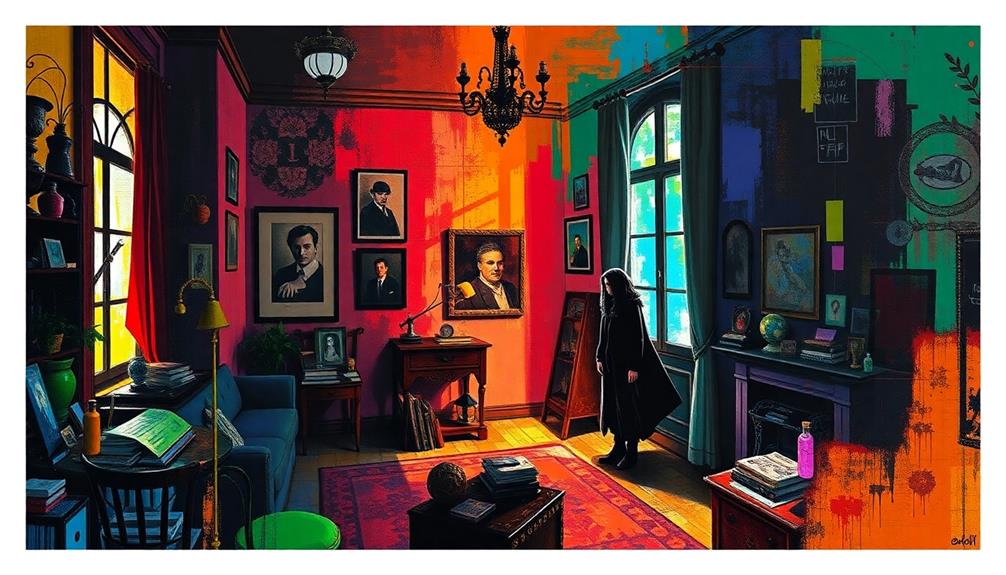James Baldwin's 'Giovanni's Room' immerses you in the life of David, an American in Paris grappling with his bisexuality. The story unfolds on the night before Giovanni's execution, heightening the tension of David's love affair with Giovanni and his engagement to Hella. You'll see how guilt, shame, and societal expectations collide within David as he ultimately chooses a conventional life over true passion. The novel confronts themes of identity, love, and repression, making it a pivotal work in LGBTQ+ literature. If you want to explore the intricate layers of character motivations and cultural impact, there's much more to uncover.
Plot Summary
In James Baldwin's "Giovanni's Room," you explore the life of David, an American expatriate in Paris, who grapples with his sexual identity and tumultuous relationships. The narrative unfolds on the night before Giovanni's execution, creating a palpable tension as David reflects on his passionate affair with the Italian bartender.
As Baldwin masterfully illustrates the complexities of love and societal pressures, David is caught between his love for Giovanni and his engagement to Hella, wrestling with the poignant exploration of shame's roots in queer life.
As David navigates the vibrant streets of Paris, he confronts the guilt stemming from his past experiences of bullying and repression. His internal conflict intensifies as letters from Hella and his father serve as constant reminders of his conventional life, forcing him to question his choices.
Ultimately, the weight of these expectations leads David to abandon Giovanni for a more traditional future.
The story culminates in David's painful realization of his culpability in Giovanni's downfall. His struggle for self-acceptance remains unresolved, leaving him emotionally scarred.
Baldwin masterfully illustrates the complexities of love, identity, and the consequences of choices, inviting you to reflect on the depths of human experience.
Character Analysis
Exploring the characters in James Baldwin's "Giovanni's Room" reveals the intricate layers of identity and desire that shape the narrative. Each character embodies different aspects of sexuality and societal expectations, creating a rich tapestry of conflict and emotion. The themes of courage and defiance are mirrored in Baldwin's work, as characters navigate their personal struggles against societal norms, reflecting the broader historical context of collective action in resistance movements.
- David: An American expatriate, he grapples with his sexual identity and internal conflicts. His relationships are marred by regret and shame, highlighting the struggle between desire and societal norms.
- Giovanni: This Italian bartender symbolizes passion and vulnerability. As David's love interest, Giovanni catalyzes David's exploration of his sexuality, but ultimately faces a tragic end due to societal prejudice.
- Hella: David's fiancée represents traditional femininity and societal expectations. Her presence amplifies David's internal conflict, forcing him to confront his hidden desires.
- Jacques: An older gay man and David's mentor, Jacques introduces him to the complexities of love within the LGBTQ+ community, offering insights that challenge David's perceptions.
These characters illustrate the profound impact of societal pressures on relationships and personal identity, ultimately culminating in tragedy for both David and Giovanni.
Major Themes

The characters in "Giovanni's Room" reveal the powerful themes that drive the narrative and resonate with readers. One of the most prominent themes is identity and self-acceptance, as you witness David's struggle with his bisexual identity amidst societal expectations. His relationships with Hella and Giovanni highlight the conflict between conforming to traditional norms and embracing personal desires.
This struggle for identity can also be seen in Ta-Nehisi Coates' work, particularly in his exploration of the complexities of racism in America, which underscores the importance of understanding one's place within societal constructs.
As you read, you can feel the impact of repression that weighs heavily on David, stemming from internalized homophobia and societal pressures. This repression leads to emotional turmoil, manifesting in guilt and regret over his love for Giovanni.
Baldwin intricately explores the complexity of love and desire, showing that deep emotional connections can exist regardless of gender, yet these attachments often come with pain.
Ultimately, the consequences of rejecting one's true self are starkly illustrated through Giovanni's tragic fate. His demise serves as a haunting reminder of the dangers associated with societal rejection and the profound cost of living a life untrue to oneself.
Through these themes, Baldwin invites you to reflect on the struggles of identity, love, and the heavy burdens of societal expectations.
Historical Context
Published in 1956, "Giovanni's Room" stands as a poignant reflection of the historical climate surrounding LGBTQ individuals in mid-20th century America. At a time when homosexual acts were criminalized, Baldwin's work exposes the societal repression faced by queer individuals, highlighting their emotional struggles in a world that largely ignored their existence.
The contributions of unsung trailblazers in the fight for justice and equality, as seen in the pioneers of social change, also resonate within Baldwin's narrative, emphasizing the significance of challenging societal norms.
Set against the backdrop of 1950s Paris, the novel symbolizes a sanctuary for sexual freedom, contrasting sharply with the conservative norms of America. Baldwin aimed to challenge the limited LGBTQ representation in literature, offering a nuanced exploration of sexual identity and the complexities of human emotions.
Consider these key aspects of the historical context:
- The gay rights movement was just beginning to gain momentum.
- Homosexuality was often stigmatized, leading to widespread societal repression.
- Baldwin, as a black gay man, confronted unique challenges related to race and sexuality.
- "Giovanni's Room" provides critical insights into the struggles of queer individuals during this tumultuous period.
In this light, Baldwin's narrative remains a crucial commentary on the intersection of love, identity, and societal constraints.
Cultural Impact

Baldwin's "Giovanni's Room" sparked a significant cultural shift in how LGBTQ+ themes were perceived and represented in literature. Published in 1956, this groundbreaking novel candidly explores sexual identity at a time when such discussions were largely taboo. Baldwin, as an American expatriate, challenges the heteronormative perspectives that dominated mid-20th-century literature, creating a narrative that resonates with those grappling with societal expectations.
The profound emotional journeys in literature, such as those found in top Christian romance fiction novels, also reflect the complexities of love and identity, adding layers to the dialogue initiated by Baldwin.
The cultural impact of "Giovanni's Room" extends beyond its initial release. It has influenced numerous adaptations, including BBC Radio dramatizations and film projects, highlighting its ongoing relevance. Readers and critics alike recognize the novel's importance in LGBTQ literature, often ranking it highly in essential reading lists.
Baldwin's exploration of race, identity, and sexuality not only enriches the discourse on intersectionality but also emphasizes the necessity for diverse representation in literature.
Today, "Giovanni's Room" remains crucial for contemporary audiences, as it invites discussions about the complexities of sexual identity and the societal constraints that shape it. Its lasting influence guarantees that Baldwin's message continues to inspire new generations, making it a cornerstone in the fight for LGBTQ+ visibility and acceptance.
Conclusion
To sum up, Baldwin's "Giovanni's Room" challenges you to confront the complexities of identity, love, and societal expectations. Just like a person grappling with their sexual orientation in a conservative family, David's internal struggles reflect the harsh realities many face. By exploring these themes, Baldwin not only captures the essence of human experience but also encourages you to embrace authenticity, reminding you that true fulfillment comes from accepting who you are, despite societal pressures.



